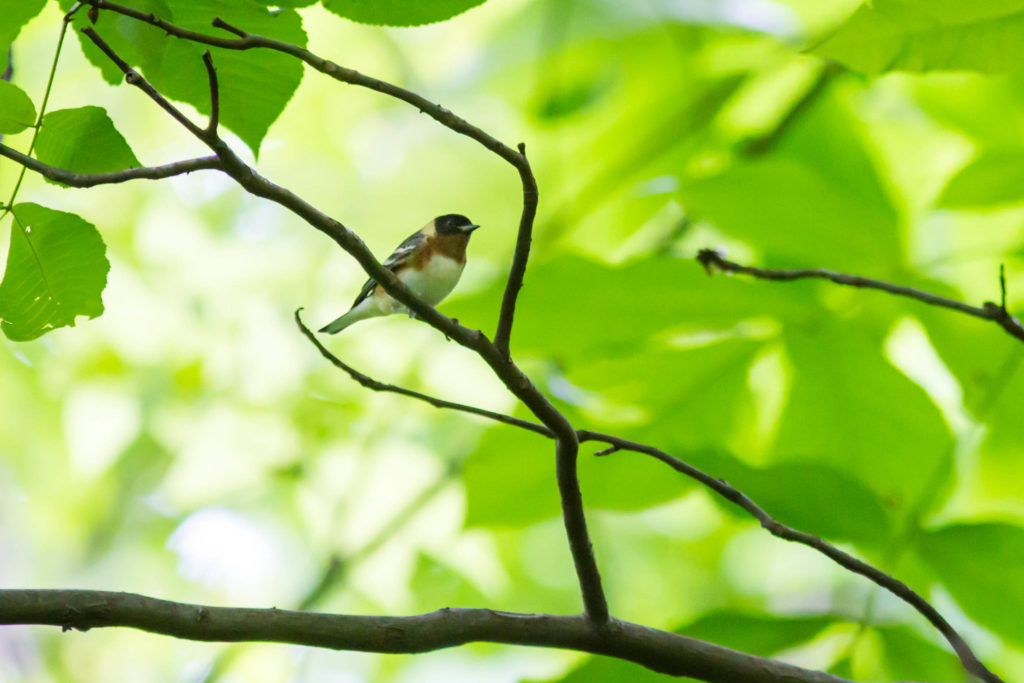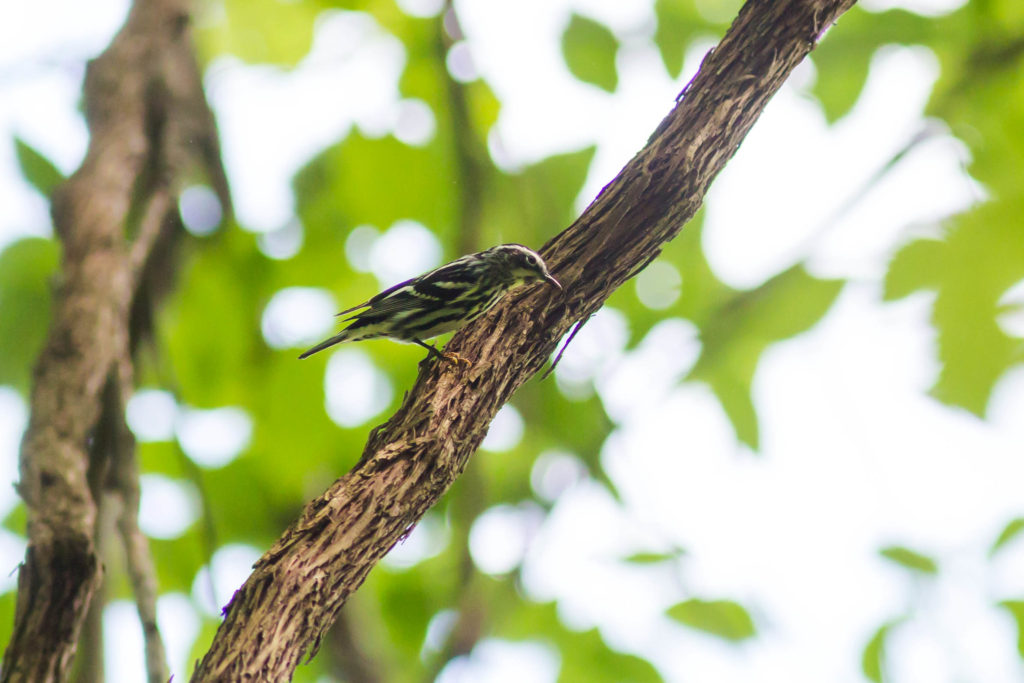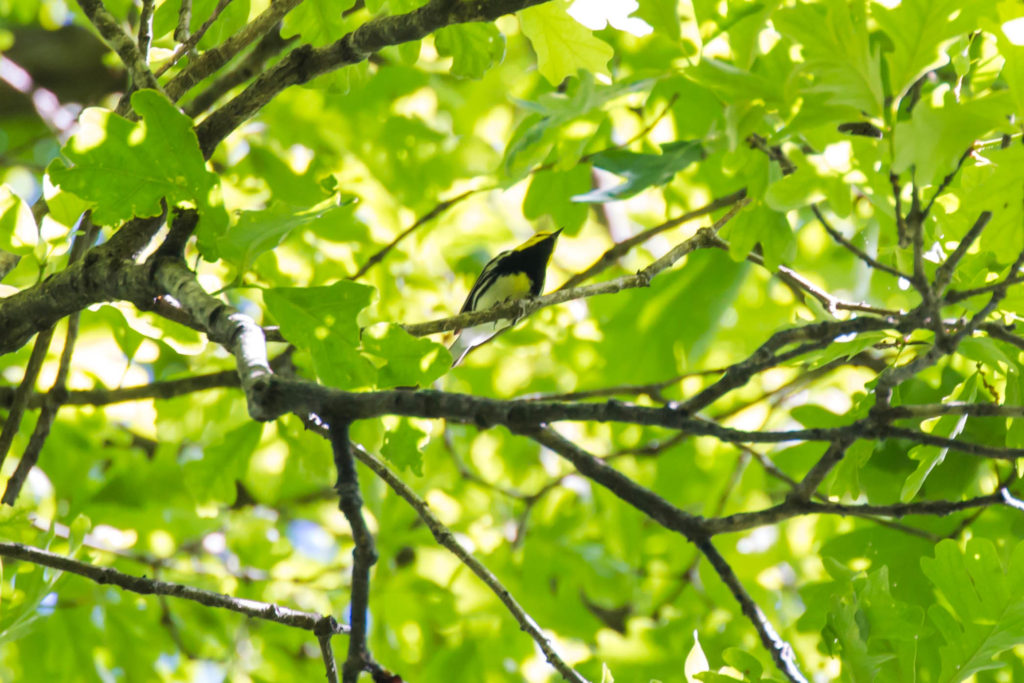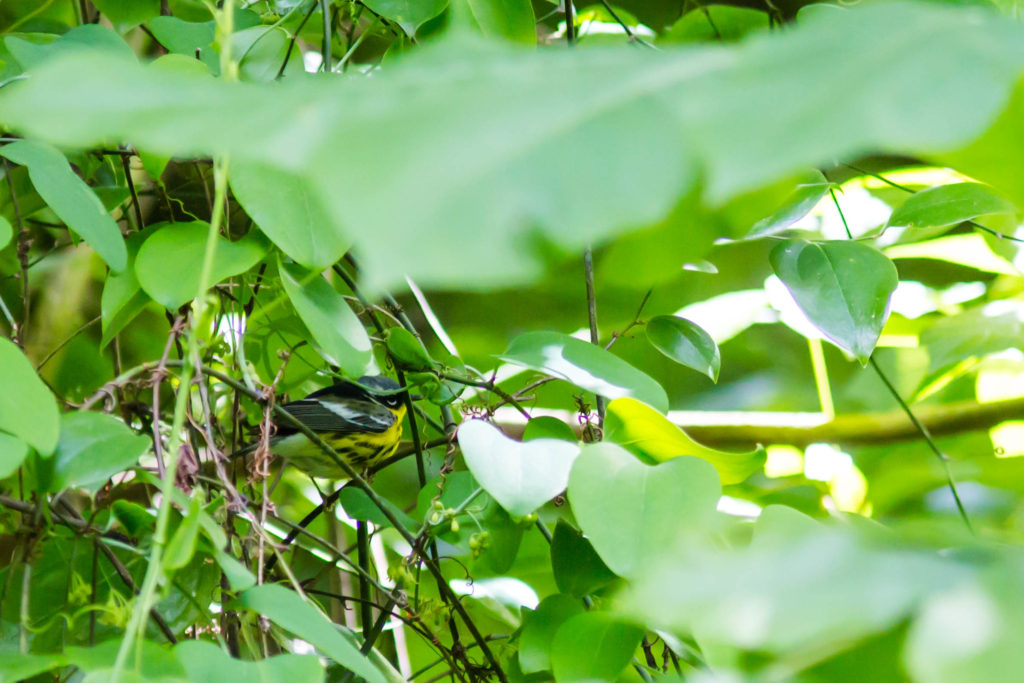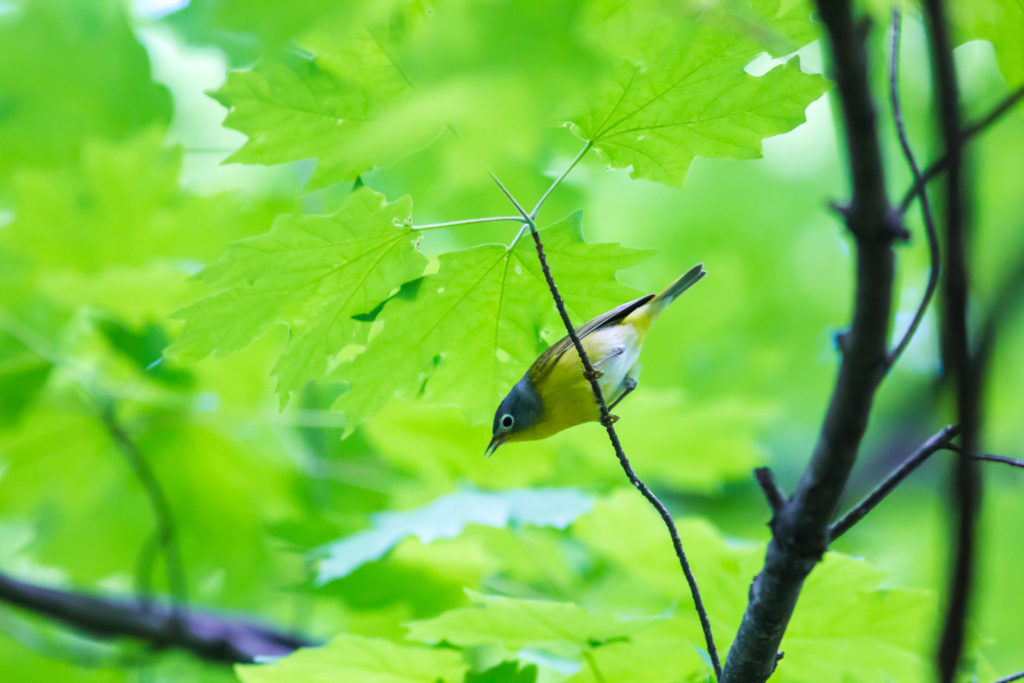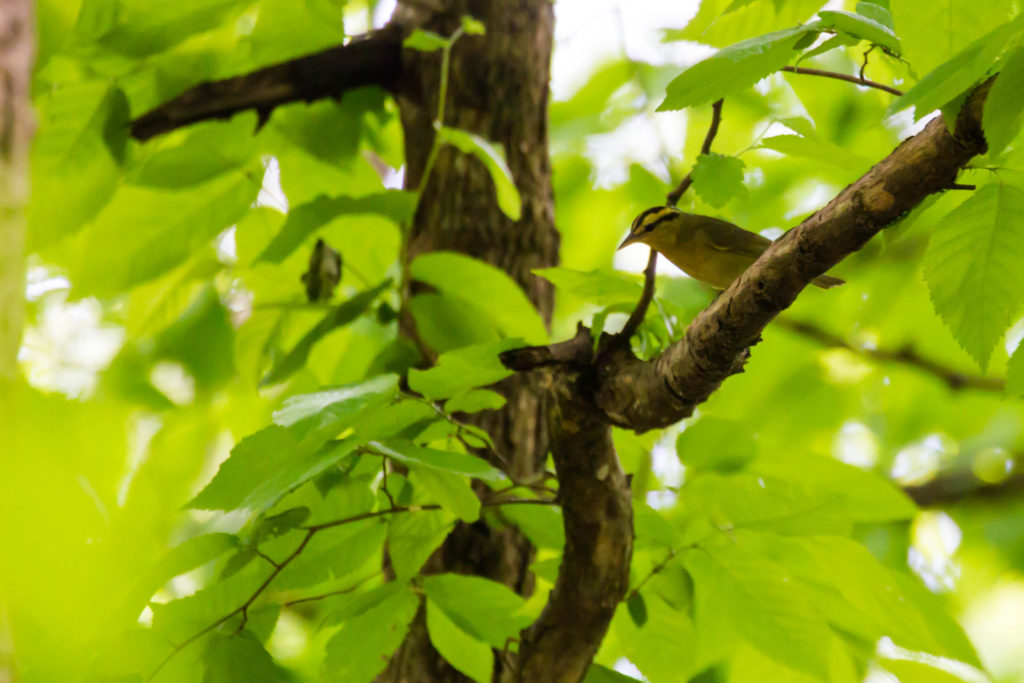Bucks for Birds #6: Warbler Wrapup
It’s time for the final set of birds in our April Bucks for Birds promotion, and we saved our most fascinating visitors for last. Over the past couple of weeks, I spotted nine different warblers, which brings our final tally to 54 species photographed in April.
We met our bird goal, which was 50 species, but not our pledge goal, which was $2,500. We cleared about $1,900, which will be a good start but won’t cover all our expenses for removing invasive nandina and mahonia.
The project itself was much more difficult than I expected it to be! There were several days when I would walk for two or three hours without finding any birds to add to the list–particularly in the morning, when birds should be most active. I still can’t explain why I had better luck in the afternoons, but I did. Early leaf-out was a killer, with the birds’ hiding places getting a three-week jump on the birds themselves. Migration itself has been slow this year, and toward the end of the month the humidity and the blanket of mosquitoes I walked through every morning started to get to me a little bit!
But like clockwork, yesterday–May 1–was probably the best birding day I’ve ever had in the Old Forest. Something like 50 warblers were happily hopping through the trees above me. I saw virtually all the species it took me a month to see within the span of ten minutes. It was such fun, and a nice coda to this project (especially since I didn’t see anything new, so I didn’t feel cheated out of extra species!).
We begin with the American redstart, a bright orange-and-black bird with an impressive tail. It frequently fans out the tail to startle the insects on which it feeds. All birders will tell you they have a nemesis bird, one that seems to elude them at every turn. Up until this month, the redstart was mine. I kept seeing flashes of it, but it moves so quickly that I had never gotten a photo of it. This month I really got a chance to observe it for a long stretch of time, and while this photo isn’t the greatest, I like that it shows the fanned tail.
During this project, I had a single bird that was brand-new to my “life list,” one I’d never seen at any point. It was the Bay-breasted warbler, whose color scheme is similar to the redstart’s but more muted. This bird’s favorite food is the spruce budworm, a forest pest. As people have sprayed spruce trees to eradicate the budworm, this bird’s food supply has been reduced, contributing to a decline in population. It’s easy to identify this bird in the spring, but in the fall its plumage turns to green and gray like many other warblers, and it blends into the crowd.
The beautiful black-and-white warbler gives me an occasion to jump on a soapbox for a moment. While you’re most likely to spot it creeping up and down tree trunks and vines looking for insects, this bird makes a cup-shaped nest on the ground in leaf litter. This means that when dogs run through a forest off-leash and off-trail, they may very well destroy the nests or young of these and other ground-nesting birds like thrushes and juncos. It’s illegal to have your dog off-leash in Overton Park and in most city parks except for in designated fenced areas like Overton Bark, and this is one of the many reasons why. Please respect the habitat of wild animals and keep your dogs on the trails. Thanks. 🙂
The black-throated green warbler has a recognizable, buzzy song that you’ve probably heard over and over if you’ve spent time in the forests of the northeastern U.S. Males sing constantly, often easily surpassing 100 songs per hour. This bird is a resident of coniferous forests, so it’s a treat to see it pass through our deciduous woods every year!
The chestnut-sided warbler looks like a child took a maroon crayon and drew a ragged streak down both sides of its body. It’s a charming bird with a black mask, a green-yellow cap, and a bright white belly. This bird thrives on a brushier habitat than many warblers, and succeeds in “second-growth” forests, so the cutting of forests may actually have helped increase this bird’s populations. John James Audubon only saw this bird once in his travels, but on a good day in the Old Forest you’ll see several quietly flitting amongst the leaves.
One of my favorites is the magnolia warbler, which combines the bright yellow we associate with warblers with a black mask, gray cap, and a streaky black “necklace.” I usually see far more of these in springtime, so I wish I’d been able to get a photo where it wasn’t hiding! Its name comes not from any special association with magnolia trees, but because the ornithologist who first spotted it happened to see it in a magnolia. It mostly prefers conifers, but here you’ll see it foraging in low trees and shrubs.
The Nashville warbler happens to have been named by the same birder (Alexander Wilson) who named the magnolia warbler–and its moniker is equally random. Wilson first spotted the bird near Nashville, but it was during migration, when a bird can turn up most anywhere between its breeding grounds and its wintering location. This bird breeds in the far northern U.S., but mostly in Canada. Its white eyering makes it distinct from most other warblers aside from the Canada warbler, which is darker overall with a streakier appearance.
You probably know what I’m going to tell you about the Tennessee warbler–that it too was named by Alexander Wilson during migration, and that it nests primarily in Canada. Its name feels more appropriate to me, though, because for a few weeks every year, the sound of this bird is almost constant. Once I learned that it sounds almost like a car struggling, but ultimately succeeding, to start, I started to know where to look. And often you have to look hard for this bird even though it’s incredibly loud, because it doesn’t have a lot of distinctive features. It’s mostly gray and white, sometimes with a wash of olive, and a pale white stripe through the eye. On the first day they come back every year, I’m so happy to hear their song again; by the second week, I’m already wishing they would cool it so I could hear the songs of the less-common warblers! They’re such a staple of our forest in spring that “Tennessee warbler” feels like the right name from my very limited perspective.
Our last warbler is one of the hardest to see, and combines the striped head of a sparrow with a warbler’s yellow coloration. The worm-eating warbler does not actually eat earthworms, but caterpillars. It does, however, forage on the ground moreso than a lot of other warblers, and it builds its nest on the ground against a tree. This bird breeds further south than many of the others in this post–in fact, it breeds throughout most of Tennessee excluding our area. That makes me want to search for worm-eating warbler fledglings and see if its range is expanding to include us!
And that’s it! Thank you so much for following along. I’ve had fun sharing a little piece of the forest with you, and I hope you enjoyed the photos. The next week or two are still within the prime migration window, so grab some binoculars and see how many of these you can spot for yourself!
The final tally (54):
- American redstart
- American robin
- Baltimore oriole
- Barred owl
- Bay-breasted warbler
- Black-and-white warbler
- Black-throated green warbler
- Blue-gray gnatcatcher
- Blue jay
- Broad-winged hawk
- Brown-headed cowbird
- Carolina chickadee
- Carolina wren
- Cedar waxwing
- Chestnut-sided warbler
- Chimney swift
- Chipping sparrow
- Downy woodpecker
- Eastern wood-pewee
- European starling
- Gray catbird
- Great blue heron
- Great crested flycatcher
- Hairy woodpecker
- Hermit thrush
- Hooded warbler
- Indigo bunting
- Magnolia warbler
- Mallard
- Mourning dove
- Myrtle warbler
- Nashville warbler
- Northern cardinal
- Northern mockingbird
- Northern parula
- Orange-crowned warbler
- Palm warbler
- Pileated woodpecker
- Red-bellied woodpecker
- Red-eyed vireo
- Red-tailed hawk
- Rose-breasted grosbeak
- Ruby-crowned kinglet
- Ruby-throated hummingbird
- Scarlet tanager
- Summer tanager
- Swainson’s thrush
- Tennessee warbler
- Tufted titmouse
- White-breasted nuthatch
- White-eyed vireo
- White-throated sparrow
- Wood thrush
- Worm-eating warbler


